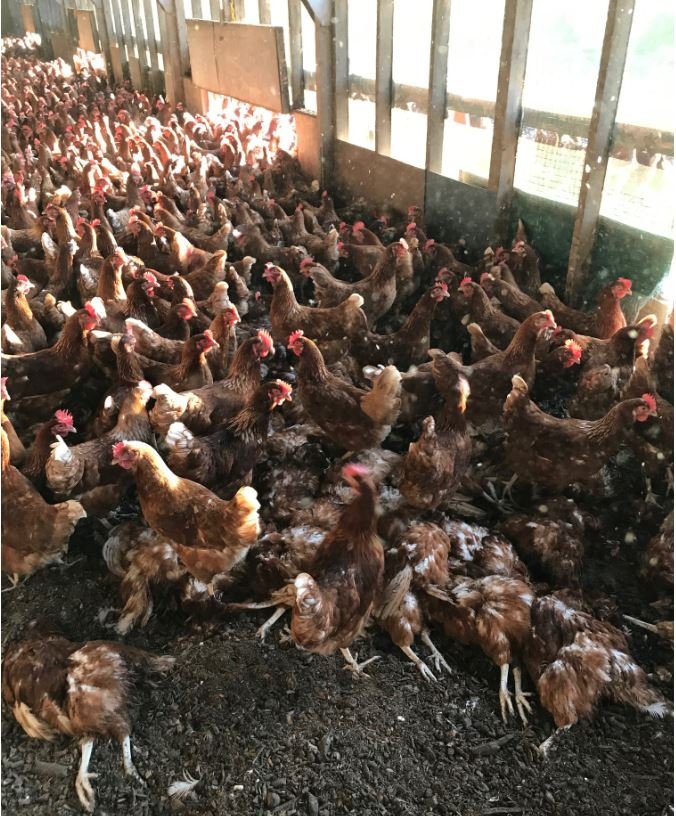
Published on Feb. 23, 2021
Smothering
Smothering in a flock of laying hens is the unfortunate event when birds mass together, often on top of each other, resulting in death from suffocation. Smothering is reported across the cage-free egg laying industry, but most frequent observed in brown egg layers. The discovery of a smother often upsets the egg producer, imagine collecting a pile of dead birds that were perfectly healthy a few hours before. Smothering can also be financially detrimental for egg producers.
In general, we distinguish between 2 types of smothering:
- Fright: This is when birds are scared by sudden noise (low flying aircraft), or sudden events (a fox or buzzard close to the poultry house). As a result, birds will pile up in the corners of sheds. Mortality can be severe but is normally a one off.
- Creeping Together: This is when birds pile up in the middle of sheds for no apparent reason (sometimes the hens simply find a favorite spot in the house, i.e. a warm place, or they can be attracted by a light beam, or the dust that is visible in that beam). Normally lower mortality is observed per event, but it can accumulate as it can be an on-going problem.
This technical paper is to help control the second type of smothering. This behavior can be very frustrating to manage especially as it is nearly always healthy birds that smother and if the stockperson is not in the unit at the exact time when they start to smother, birds can die very quickly.

result of a smother event
Some characteristics of smothering
- There is no known reason why the birds creep together
- It occurs in different places in the house, independent of the house type
- Can happen outdoors
- Unpredictable
- It is most common between the age of 10–13 weeks and 20-28 weeks (peak-period)
- All brown chicken breeds
- Seems to be a stress-situation (restriction-peak production)
This behavior can be habitual. E.g. if birds smother due to light ingress the source can be removed but birds can carry on smothering, even to the point of smothering at the same time every day. The most likely time for smothering to occur is in the afternoon after egg laying.
A video in which the typical smothering behavior has been captured
Possible reasons
Fear:
- In the wild, hens are “shadow animals” – they like shade.
- Therefore light intensity might play a role.
- Hens naturally look for protection from predators above.
- They come close together looking for safety.
- In aviary systems less problems as there is more protection from above.
Stress: in stress situations they feel unhappy and creep together. These include:
- Periods of restriction or too low feed intake.
- The onset of lay (competing for next box space resulting in nest box smothering)
- Peak-production.
- Feed composition: Changes in raw materials and palatability may trigger stress, diet composition may not satisfy – the inclusion of crude fiber may help.
- Feed times – at inappropriate times. i.e. during laying period.
- Temperature extremes or draughts.
Possible Solutions:
- If birds smother in the same area place a pallet on the area to break up the floor and so the birds at the bottom of a smother can still breathe.
- Ensure clear access to nests boxes + sufficient nest boxes.
- Consider changing the time clocks e.g.: for one day put the birds to bed an hour early, this will break the bird’s routine and break the habit.
- In the afternoon run the feeders more often to keep birds occupied. Time feeds so they start to bare the tracks in the middle of the day. In this way, when you give extra feeds in the afternoon the birds are hungry. This is a good general management tool on all flocks – it helps keep the ration in the feeders fresh, develops appetite and ensures the ration is consumed at the right end of the day for egg production. Take care not to stress the birds with restriction though.
- Give a scratch feed in the afternoon (e.g.: oats) – this will keep the birds occupied. Be aware that once you commence this technique you must continue every day.
- If birds congregate between pop holes shut a pop hole to reduce draughts and hang plastic bags above the area they tend to smother.
- When floor walking, change the route you walk, go through as quickly as possible especially in the afternoon but increase the amount of inspections at the times when birds smother.
- Electrify the walls and corners with low voltage netting or wires (always check local permissions first).
- Experience tells us that some smothers of this time can come from a desire to perch and that the provision of additional A-frame or other types of perching can eliminate the problem.
Conclusions
As it is so hard to predict smothering, it is difficult to completely eliminate this behavior from your flock. Observing the flock during a smothering event might help you to give you answers why your flock smothers. We have tried to give you possible reasons that could result in smothering, and several solutions that may help to prevent smothering. We, as Hendrix Genetics, are collaborating together with Wageningen University and Research, Utrecht University, Eindhoven University of Technology, and the Vencomatic group, in the IMAGEN project. In this IMAGEN program, the researchers will develop an Artificial Intelligence system to automatically detect individual behaviors in large groups of pigs and laying hens. The system should automatically detect actors and victims of anti-social behaviors such as smothering and feather pecking.
